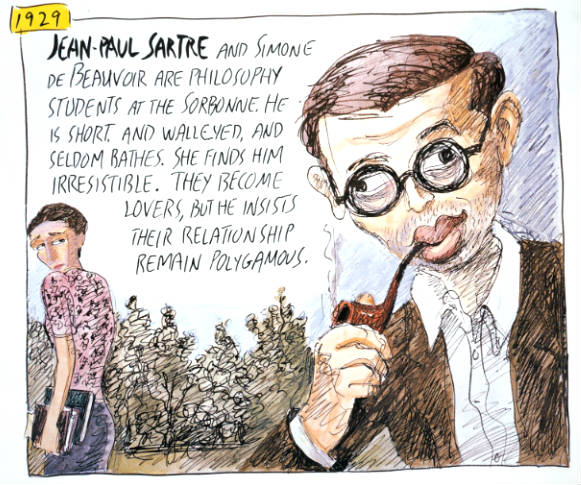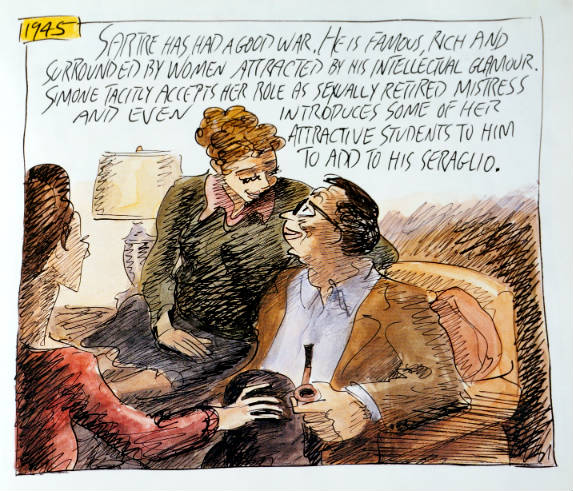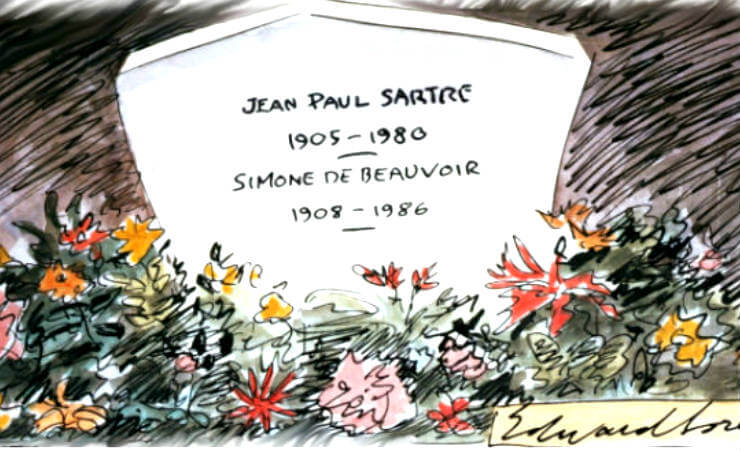Existentialists in Love…
Award-winning caricaturist, Edward Sorel, entertains us with his art in Literary Lives – showing us the bizarre, scandalous, and often unknown world of 10 distinguished writers.
Sorel creatively depicts Marcel Proust peering through keyholes at the clientele of a male brothel. We learn about Ayn Rand’s long love-affair with Nathaniel Branden, a student half her age (while both are married to other people). Sorel also introduces us to the self-indulgent years of Leo Tolstoy. Other authors caricatured in the book include: William Butler Yeats, Norman Mailer, George Eliot, Bertolt Brecht, Jean-Paul Sartre, Carl Jung, and Lillian Hellman.
Literary Lives reminds us that truth can in fact be stranger than fiction and, ‘that great authors are not only the geniuses we believe them to be, but often quite mad as well’.
Not sure if Jean-Paul Sartre would qualify as ‘mad’, but some of his behaviors – especially toward women – were far from standard.
Jean-Paul Sartre and Simone de Beauvoir (French existentialist philosopher and writer) first met in 1929 while both were studying philosophy at the Sorbonne (University of Paris).

1929 Jean-Paul Sartre and Simone de Beauvoir are philosophy students at the Sorbonne. He is short and walleyed, and seldom bathes. She finds him irresistible. They become lovers, but he insists their relationship remain polygamous.
Both Beauvoir and Sartre wanted an ‘open’ relationship. However, there was a time when Sartre did ask Beauvoir to marry him (1931). He was turned down.
An existentialist, after all, does not approve of labels, and a relationship commitment lacked the freedom that they both valued.
After graduation, they ended up getting jobs at different schools, yet still remained very close. However, Sartre continued to have sexual encounters with several other women.
He insisted on having an open relationship and even wrote to Beauvoir with details of his sexual experiences.
They remained nearly inseparable throughout the rest of their lives, yet neither one believed in marriage.
Even in his old age, Sartre still fancied the ladies. He even got help from his life-long companion – Beauvoir introduced ‘some of her attractive students to him’.

1945 Sartre has had a good war. He is famous, rich and surrounded by women attracted by his intellectual glamour. Simone tacitly accepts her role as sexually retired mistress and even introduces some of her attractive students to him to add to his seraglio.
Their relationship was open and honest – they both knew where they stood. And Beauvoir had her own relationships outside of the one she had with Sartre – with both men and women.
In the end however, they are together. They are buried next to each other at Montparnasse Cemetery in Paris (Sartre dying in 1980 and Beauvoir in 1986).


Leave a Reply